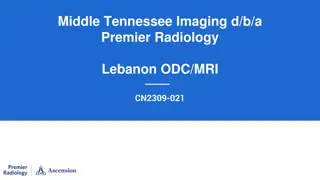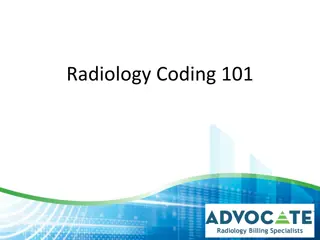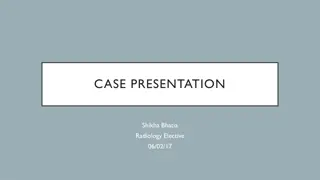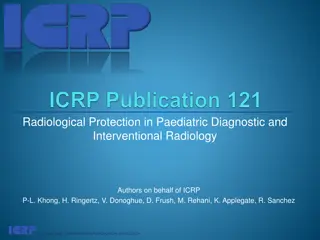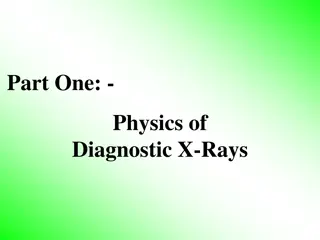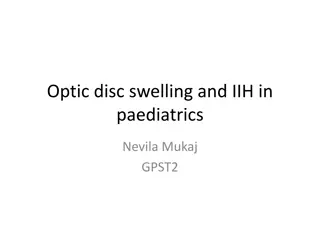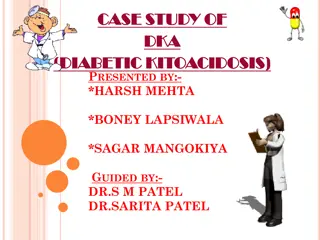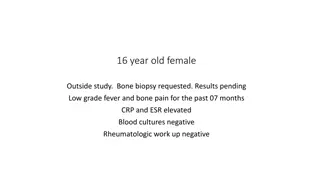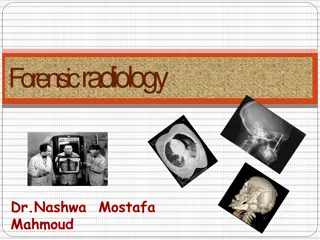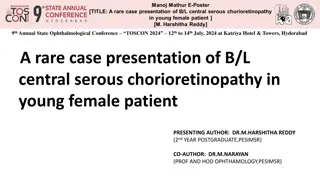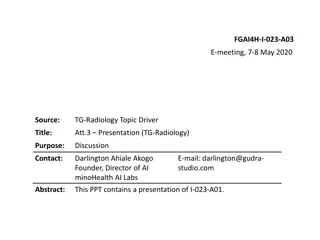Advanced Neurodegeneration in a 50-Year-Old Female: A Diagnostic Radiology Case Study
Patient Nicole Thomason, a 50-year-old female, presented with memory concerns and progressive cognitive decline. Initial imaging showed subtle changes, while recent PET CT revealed marked hypometabolism in specific brain regions indicative of advanced neurodegenerative disorder, potentially Alzheimer's disease and frontal temporal dementia. Treatment includes donepezil and escitalopram.
Download Presentation

Please find below an Image/Link to download the presentation.
The content on the website is provided AS IS for your information and personal use only. It may not be sold, licensed, or shared on other websites without obtaining consent from the author. Download presentation by click this link. If you encounter any issues during the download, it is possible that the publisher has removed the file from their server.
E N D
Presentation Transcript
Advanced Neurodegeneration Nicole Thomason Date Diagnostic Radiology (RAD 4001) Dr. Shekhar Khanpara
Clinical History Patient is a 50 yo F who presented to an outpatient clinic with her husband for concerns about her memory. Her symptoms began suddenly a year and a half ago when she lost her ability to write. At this time the patient initially had an MRI done in Fort Worth. Since then her symptoms have gradually progressed and now she reports difficulties writing, reading, holding conversations, recall, maintaining concentration as well as memory loss, getting lost in familiar places, and an inability to balance her checkbook. Some of her ADLs have also been affected and she has experienced worsening anxiety. Denies tremors, falls, difficulty walking, incontinence, changes in weight, strokes, sleep changes, changes in temper, changes in personality, hallucinations
Clinical History Physical Exam: Mental status exam revealed that patient is oriented to person but not place or time. She has impaired memory and calculation abilities. No dysphasia/aphasia. The remainder of the physical exam (including a full neuro exam) revealed no abnormalities. PMH: Hypertension controlled with medications, undefined thyroid nodules, anxiety/depression FAM HX: No fam hx of memory issues. SOCIAL HX: Drinks a small amount of alcohol 1x per month
Clinical History Previous imaging at the initial onset of symptoms (1.5yrs ago) showed only: Mild generalized changes advanced for the patient's given age. No disproportionate atrophy. Subtle foci of T2/FLAIR hyperintensity within the periventricular white matter bilaterally (nonspecific finding that can be seen in patients with migraine headaches or as the sequela of chronic small vessel ischemia); were not able to acquire actual images Steps after Clinic visit: Ordered: FDG PET Scan Bloodwork (CBC, CMP, FBS, Lipids, HgbA1c, TFT, Thiamine, Vitamin B12, Folate, CK, ESR, RPR, Apo E. Include PS1, PS2, and APP mutation analyses, FTD genetic analyses, and the NMDA-R antibody) Started on donepezil and escitalopram
Relevant Imaging PET CT (01/08/21)
Relevant Imaging PET CT (01/08/21)
More relevant imaging CT/PET Findings Mild cerebral atrophy on corresponding CT Images Marked symmetrical hypometabolism within bilateral parietal and middle and posterior temporal lobes Areas of hypometabolism are also seen within bilateral anterior frontal lobes Symmetrical FDG uptake is seen within bilateral occipital lobes, posterior frontal lobes, and basal ganglia Findings suggestive of advanced neurodegenerative disorder, mixed with the Alzheimer s disease and the frontal temporal dementia
Highlight and summarize key imaging findings Alzheimer s Disease Bilateral, symmetric hypometabolism in the temporoparietal, precuneus and posterior cingulate areas The anterior cingulate, visual cortex, basal ganglia, thalami, occipital lobes, and cerebellum are usually spared
Highlight and summarize key imaging findings Frontotemporal Dementia frontal and temporal lobes are predominantly affected, depending on the genetic and clinical phenotype, individuals demonstrate very variable regional atrophy. Can be asymmetric
Differential Diagnosis Alzheimers Disease Sx s: memory concerns, a change in writing, a change in multi-tasking, concentrating issues, etc. Imaging: Bilateral, symmetric hypometabolism in the temporoparietal lobes Frontotemporal Dementia Sx s: concentration/executive issues Imaging: bilateral anterior frontal lobe hypometabolism; temporal lobe hypometabolism Vascular Dementia: Sx s: wide variety of neurocognitive symptoms Imaging: Better imaged on CT/MRI than PET scan but with no evidence on previous MRI
Discussion Working diagnosis of Advanced Neurodegeneration DIFFUSE decrease in uptake on PET scan can explain symptoms but does not perfectly fit a diagnosis in this patient Characteristics of both Frontotemporal Dementia and Alzheimer s Disease Further work up: Bloodwork: CBC, CMP, FBS, Lipids, HgbA1c, TFT, Thiamine, Vitamin B12, Folate, CK, ESR, RPR, Apo E. Include PS1, PS2, and APP mutation analyses, FTD genetic analyses, and the NMDA-R antibody. Meds: start donepezil 5 mg po qAM today and go to 10 in 1 month. EEG
Final Diagnosis Working diagnosis of Advanced Neurodegeneration
ACR appropriateness Criteria Cost of PET-CT: https://www.newchoicehealth.com/places/texas/houston $1500 - $4000
ACR appropriateness Criteria Hypometabolism on FDG-PET is thought to be related to decreased synaptic activity and is a biomarker of neurodegeneration or neuronal injury. CMS has made FDG-PET available to Medicare recipients to assist with the diagnosis of dementia in the appropriate clinical setting (eg, to distinguish AD from FTD) in recognition of this usefulness. FDG-PET is an established tool for differentiating FTD and AD and classifying different FTD subtypes. CMS coverage for payment for FDG-PET brain to differentiate AD and FTD in patients with documented cognitive decline of at least 6 months and a recently established diagnosis of dementia.
Take Home Points / Teaching points FDG-PET is an imaging study that can give an idea of metabolic rates in certain areas FDG-PET can differentiate types of dementia that are hard to differentiate clinically or with CT/MRI Alzheimers Disease will show bilateral, symmetric hypometabolism in the temporoparietal lobes Frontotemporal Dementia will show anterior frontal lobe and temporal lobe hypometabolism and can be asymmetric
References Images: https://media.sciencephoto.com/image/m1400034/800wm https://radiopaedia.org/cases/brain-lobes-annotated-mri-1 https://radiologykey.com/wp- content/uploads/2016/09/A308863_1_En_15_Fig4_HTML.jpg ACR Appropriateness Criteria https://acsearch.acr.org/docs/3111292/Narrative/




